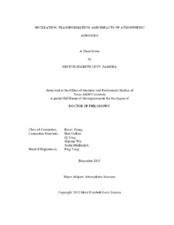| dc.description.abstract | Atmospheric aerosols are a key contributor to pollution, adversely affect human health, and can alter global climate. Several questions concerning atmospheric aerosols persist, including: ‘Which atmospheric species are integral for aerosol formation in the atmosphere?’, ‘What happens to aerosols after emission into or formation in the atmosphere?’, ‘Does maternal exposure to aerosols during pregnancy fundamentally alter her offspring?’, and ‘Can we utilize gas phase chemistry models to further our understanding of atmospheric aerosols?’. A series of chamber, observational, and computational studies have been conducted to investigate these scientific questions.
Globally, new particle formation (NPF) events account for more than 50% of the aerosols in the troposphere, but the chemical species and mechanisms responsible for NPF have yet to be fully understood. To explicate the role of organic compounds in NPF, laboratory experiments have been conducted to investigate aerosol nucleation and growth from the photochemical oxidation of biogenic and anthropogenic volatile organic compounds (VOCs). Here we show that the NPF is dependent on the VOC species and that the global pattern of NPF is likely governed by the available VOCs.
A suite of instruments was deployed in Beijing to measure a comprehensive set of aerosol properties in order to elucidate the aerosol formation mechanisms and the evolution of aerosol properties. NPF consistently occurred on clean, windy days, and the high aerosol mass observed during haze events is attributable to the continuous growth from the nucleation-mode particles over multiple days to produce a high concentration of larger particles. Our results reveal that the severe haze in Beijing is likely due to the concentrated aerosol precursor gases and the large-scale meteorological conditions. Model simulations indicate that the persistent high concentrations of NO2 in Beijing and the frequent periods of high aerosol loading leads to elevated HONO levels and sustained oxidizing capacity.
To determine the mechanism through which aerosols influence human health, a series of animal exposure studies have been conducted to investigate the transgenerational effects. In each experiment, Sprague-Dawley rats were continuously exposed between days 0 and 18 of gestation to controlled conditions to represent either clean (~5 µg m^-3) or polluted (~150 µg m^-3) environments. The gestation length, litter size, birth weight, and sex ratio were assessed throughout the animal exposure studies. The preliminary results indicate the development of several organs and the birth weight may be influenced by prenatal exposure to pollutants and the degree of response may also be sex dependent. | en |


